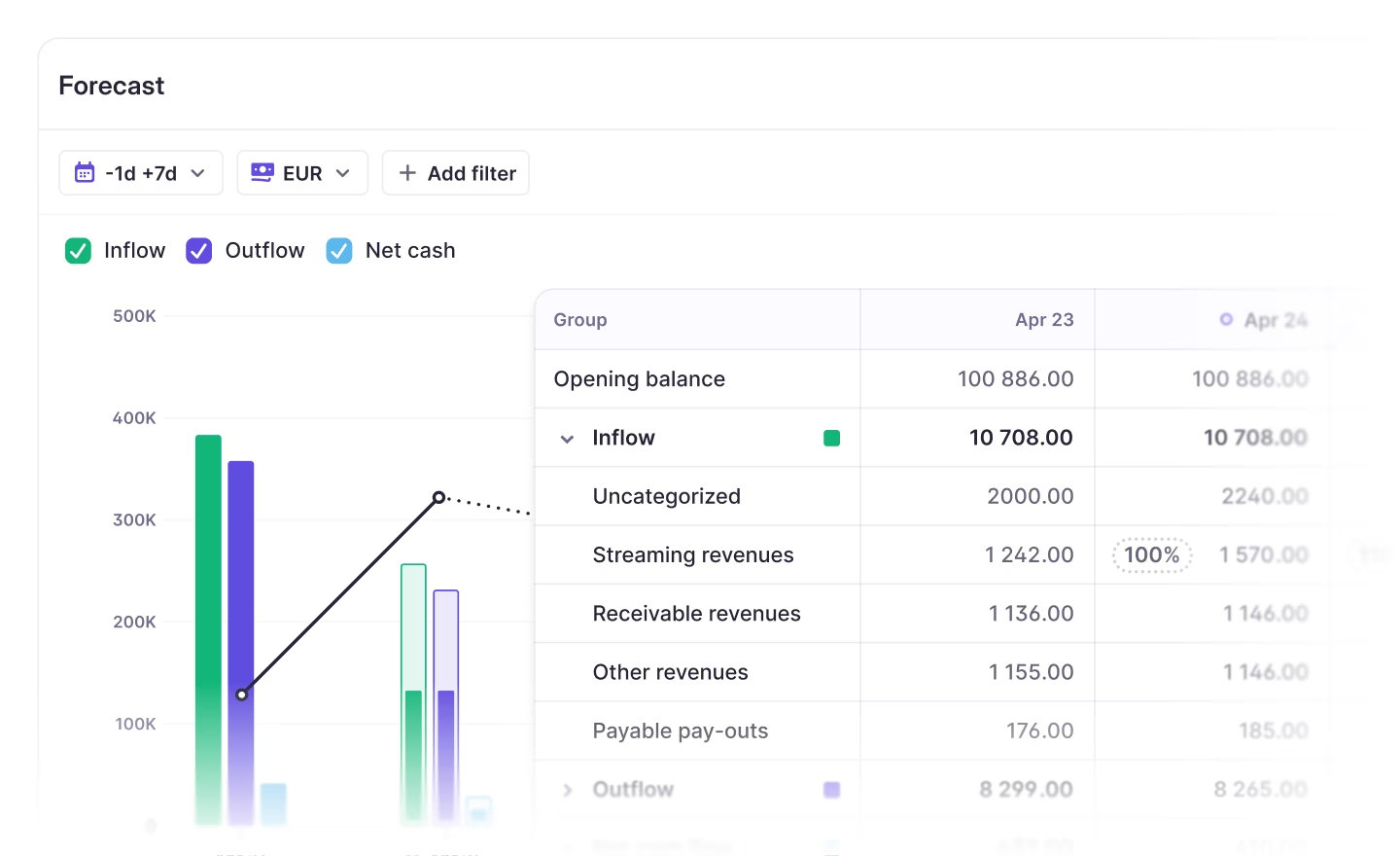What is cash flow forecasting?
Cash flow forecasting projects cash inflows and outflows into the future in order to predict your cash position and plan for potential surpluses or shortfalls.

Introduction to cash flow forecasting
Cash flow forecasting is the process of projecting the flow of cash in and out of your business over a given period. In contrast to cash positioning and cash flow analysis, which looks back over your past performance to assess your business’ health, cash forecasting looks forward to predict its future viability. Scenario planning is a key component of forecasting, as companies typically want to compare their base forecast against a best and worst-case scenario.
The accuracy of a company's forecast depends on the quality of its input data. It's common to routinely assess this accuracy by conducting variance analysis on a regular basis.
Check our cash flow forecasting guide to learn more about the topic and the 13-week forecast specifically.

Objectives of cash flow forecasting
How you approach your forecasting will depend on the business objective you want the forecast to support. Below are some of the most common objectives for cash forecasting.
Financial reporting
Probably the most common objective is to project your cash levels for key financial reporting moments such as month-end, quarterly review, or annual report.
Liquidity management
Cash forecasting helps you maintain sufficient liquidity by predicting cash inflow and outflow. For example by looking at when customer payments are likely to come in and when expenses need to be paid you might identify potential cash shortfalls or surplus in advance. This allows you to optimize your cash position. For example, a surplus of cash could be invested while a deficit could be offset by selling some assets and thereby avoiding a liquidity crisis.
Financial planning
Cash forecasting is central to your financial planning and budgeting. By evaluating historical data and market trends, alongside your business plans, you can predict future cash flow. This allows you to set realistic goals, allocate resources, and monitor your performance.
Scenario planning
Cash forecasting can be used to create and analyze different financial scenarios to assess their impact on cash flows. This is typically done by comparing a base forecast against the best and worst-case scenarios. You can then use this to decide how much cash you need to produce to provide a cushion without resulting in an inefficient surplus.
Working capital management
By forecasting cash inflow from sales and cash outflow for operating expenses, you can optimize your accounts receivable and pay cycles to improve your working capital efficiency.
Debt management
By accurately forecasting cash inflow you can ensure timely debt repayment, maintain a positive relationship with your creditors, and avoid defaulting on your loans.
Investment decisions
By assessing future cash flow and liquidity requirements, you can evaluate the feasibility of potential investments. These might be capital expenditure, a business acquisition, or expansion into new markets. You can then allocate your resources accordingly to maximize returns and mitigate risk.
Cash forecasting periods
Once you’ve determined the objective of your cash flow forecast, you’ll need to decide how far into the future you want to look. Of course, the further into the future you go, the less reliable the forecast is likely to be. Choosing the right timeframe can have a huge impact on the reliability of your forecast.
Short-term
This is typically the next two to four weeks and serves to ensure you have enough cash to pay upcoming liabilities such as salaries and loan interest or repayments. Day-to-day granularity is vital. This data will typically be found in your treasury management system and includes invoicing and financial data such as foreign exchange and loans.
Medium-term
This typically looks between two and six months into the future and provides a projected balance that confirms you’re in a position to meet your debt repayments and that you’re not headed for a liquidity crisis. The most common mid-term forecast is the 13-week cash flow forecast. This data will typically be found in your treasury management system and includes order data and financial data such as foreign exchange and loans.
Long-term
This typically looks 6–12 months ahead and is often the basis for your annual budgeting. It evaluates whether you have the cash needed to support your growth plans, such as hiring, business acquisition, or office expansion. The data for this forecasting will be found in your profit and loss forecasts, internal budgets, and financial data such as foreign exchange and loans.
Mixed-term
This combines a mix of short, medium, and long-term forecasting and is typically used to manage your liquidity. For example, a mixed-term forecast might start with weekly forecasts and then move to monthly after the first few months.
Methods of cash forecasting
Just like cash flow analysis, there are two types of forecasting methods: direct and indirect.
Direct method
This involves projecting cash inflow and outflow according to specific transactions, such as customer payments, supplier invoices, and other operating expenses. It provides granular view but also requires access to in-depth transactional data, which can be time-consuming to wade through. As such, it’s better reserved for short-term cash forecasting when you need to confirm you have enough funds to continue day-to-day operations.
Indirect method
This method is achieved by analyzing financial statements, such as income statements and balance sheets, to forecast cash flow. It’s much quicker and easier than the direct method but the result is much less detailed. As such, it is better for long-term forecasting when you need to ascertain whether you have the funds to support long-term growth strategies.
Cash forecast process
At a high level, a typical forecasting process can be broken down as follows:
- Retrieve data from banks
- Retrieve data from internal systems such as your TMS and ERP
- Subsidiaries validate the data is correct and / or add their own
- Subsidiaries confirm the forecast
- Treasury team uses consolidated group forecast for reporting and liquidity planning
- Rebase forecast (sometimes weekly)
- Confirm forecast accuracy over time
To see the step-by-step process for a 13-week cash flow forecast specifically, check out our 13-week forecasting deep-dive. Here's a brief overview:
- Map out stakeholder requirements
- Design the 13-week forecast model
- Select your headline classifications
- Identify data sources for actual and forecast cash flow data
- Collect data on cash inflows and outflows
- Forecast net cash flow and closing cash balances
- Incorporate scenario analysis (optional)
- Perform variance analysis (optional)

How Atlar can help with cash flow forecasting
Atlar's cash flow forecasting solution lets you create forecasts for any bank account and time horizon with a single click – while automating the data collection work that usually takes days if not weeks.
The Atlar platform consolidates your financial data across multiple sources, including your banks and ERP system, while transactions can be automatically categorized and labeled. This lets teams focus on analysis and decision-making rather than the grunt-work of creating a forecast manually.
You can set your forecasts to update dynamically over time or adjust them on demand by adding your own inputs manually. And our scenario planning tool lets you simulate the cash flow impact of potential investments, hiring, changes in revenue, and more.
To learn more, book a demo and see our user-friendly forecasting tools in action.

You can unsubscribe anytime.
Further reading
See Atlar in action.
Enter your work email to watch a live product demo.


